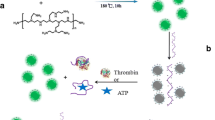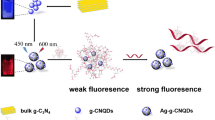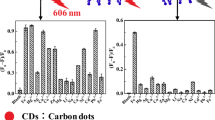Abstract
We describe the preparation of carbon quantum dots (C-dots) by a one-step hydrothermal method starting from o-aminophenol as the precursor. The C-dots exhibit bright both blue fluorescence (with excitation/emission peaks at 300/410 nm and with quantum yield of 0.40) and green fluorescence (420/500 nm; QY 0.28) without any other element doping. The unique emission properties are attributed to a synergistic effect of amino and hydroxy groups on the surface of the C-dots. The C-dots are shown to be viable fluorescent probes for heparin. The positively charged surface amino groups are assumed to interact with sulfate and carboxy groups in heparin via electrostatic interactions and hydrogen bonding. This causes the blue fluorescence of C-dots to be turned off (quenched). Fluorescence is strongest at a pH value of 6. The fluorometric calibration plot is linear in the 10 to 100 nM concentration range, with an 8.2 nM detection limit (at a signal-to-noise ratio of 3).

Carbon quantum dots with dual fluorescence emission bands were synthesized and are shown to be a viable fluorescent probe for heparin.





Similar content being viewed by others
References
Sun YP, Zhou B, Lin Y et al (2006) Quantum-sized carbon dots for bright and colorful photoluminescence. J Am Chem Soc 128:7756–7757
Chen SM, Xiong CQ, Liu HH, Wan QQ, Hou J, He Q, BaduTawiah A, Nie ZX (2015) Mass spectrometry imaging reveals the sub-organ distribution of carbon nanomaterials. Nat Nanotechnol 10:176–182
Wang XF, Zhang J, Zou WS, Wang RX (2015) Facile synthesis of polyaniline/carbon dot nanocomposites and their application as a fluorescent probe to detect mercury. RSC Adv 5:41914–41919
Kwon W, Do S, Lee J, Hwang S, Kim JK, Rhee SW (2013) Freestanding luminescent films of nitrogen-rich carbon nanodots toward large-scale phosphor-based white-light-emitting devices. Chem Mater 25:1893–1899
Zheng M, Liu S, Li J et al (2014) Integrating oxaliplatin with highly luminescent carbon dots: an unprecedented theranostic agent for personalized medicine. Adv Mater 26:3554–3560
Liu J, Liu Y, Liu NY et al (2015) Metal-free efficient photocatalyst for stable visible water splitting via a two-electron pathway. Science 347:970–974
Qu S, Wang X, Lu Q, Liu X, Wang L (2012) A biocompatible fluorescent ink based on water-soluble luminescent carbon nanodots. Angew Chem Int Ed 51:12215–12218
Xu XY, Ray R, Gu YL, Ploehn HJ, Gearheart L, Raker K (2004) Electrophoretic analysis and purification of fluorescent single-walled carbon nanotube fragments. J Am Chem Soc 126:12736–12737
Zhou J, Booker C, Li R, Zhou X, Sham TK, Sun X (2007) An electrochemical avenue to blue luminescent nanocrystals from multiwalled carbon nanotubes. J Am Chem Soc 129:744–745
Ray SC, Saha A, Jana NR, Sarkar R (2009) Fluorescent carbon nanoparticles: synthesis, characterization, and bioimaging application. J Phys Chem C 113:18546–18551
Yang Y, Cui J, Zheng M, Hu C, Tan S, Xiao Y (2012) One-step synthesis of amino-functionalized fluorescent carbon nanoparticles by hydrothermal carbonization of chitosan. Chem Commun 48:380–382
Wang Q, Liu X, Zhang L, Lv Y (2012) One-step synthesis of amino-functionalized fluorescent carbon nanoparticles by hydrothermal carbonization of chitosan. Analyst 137:5392–5397
Liu C, Zhang P, Tian F, Li W, Li F, Liu W (2011) One-step synthesis of surface passivated carbon nanodots by microwave assisted pyrolysis for enhanced multicolor photoluminescence and bioimaging. J Mater Chem 21:13163–13167
Zhai X, Zhang P, Liu C, Bai T, Li W, Dai L (2012) Highly luminescent carbon nanodots by microwave-assisted pyrolysis. Chem Commun 48:7955–7957
Yang XM, Zhuo Y, Zhu SS, Luo YW, Feng YJ, Dou Y (2014) Novel and green synthesis of high-fluorescent carbon dots originated from honey for sensing and imaging. Biosens Bioelectron 60:292–298
Guo Y, Yang LL, Li WW, Wang XF, Shang YH, Li BX (2016) Carbon dots doped with nitrogen and sulfur and loaded with copper(II) as a Bturn-on fluorescent probe for cystein, glutathione and homocysteine. Microchim Acta 183:1409–1416
Chen BS, Li FM, Li SX et al (2013) Large scale synthesis of photoluminescent carbon nanodots and their application for bioimaging. Nanoscale 5:1967–1971
Chen MY, Wang WZ, Wu XP (2014) One-pot green synthesis of water-soluble carbon nanodots with multicolor photoluminescence from polyethylene glycol. J Mater Chem B 2:3937–3945
Tang WJ, Wang Y, Wang PP, Di JW, Yang JP, Wu Y (2016) Synthesis of strongly fluorescent carbon quantum dots modified with polyamidoamine and a triethoxysilane as quenchable fluorescent probes for mercury (II). Microchim Acta 183:2571–2578
Hao TF, WeiX NYJ, Xu YQ, Yan YS, Zhou ZP (2016) An eco-friendly molecularly imprinted fluorescence composite material based on carbon dots for fluorescent detection of 4-nitrophenol. Microchim Acta 183:2197–2203
Lai CW, Hsiao YH, Peng YK, Chou PT (2012) Facile synthesis of highly emissive carbon dots from pyrolysis of glycerol; gram scale production of carbon dots/SiO2 for cell imaging and drug release. J Mater Chem 22:14403–14409
Hsu PC, Shih ZY, Lee CH, Chang HT (2012) Synthesis and analytical applications of photoluminescent carbon nanodots. Green Chem 14:917–920
Zhu C, Zhai J, Dong S (2012) Bifunctional fluorescent carbon nanodots: green synthesis via soy milk and application as, metal-free electrocatalysts for oxygen reduction. Chem Commun 48:9367–9369
Liu S, Tian J, Wang L, Zhang Y, Qin X, Luo Y (2012) Hydrothermal treatment of grass: a low-cost, green route to nitrogen-doped, carbon-rich, photoluminescent polymer nanodots as an effective fluorescent sensing platform for label-free detection of Cu (II) ions. Adv Mater 24:2037–2041
Lin LP, Song XH, Chen YY et al (2015) One-pot synthesis of highly greenish-yellow fluorescent nitrogen-doped graphene quantum dots for pyrophosphate sensing via competitive coordination with Eu3+ ions. Nanoscale 7:15427–15433
Liu Y, Xiao N, Gong NQ, Wang H, Shi X, Gu W, Ye L (2014) One-step microwave-assisted polyol synthesis of green luminescent carbon dots as optical nanoprobes. Carbon 68:258–264
Ge JC, Jia QY, Liu WM, Guo L, Liu QY, Lan MH, Zhang HY, Meng XM, Wang PF (2015) Red-emissive carbon dots for fluorescent, photoacoustic, and thermal theranostics in living mice. Adv Mater 27:4169–4177
Sun XC, Brückner C, Lei Y (2015) One-pot and ultrafast synthesis of nitrogen and phosphorus co-doped carbon dots possessing bright dual wavelength fluorescence emission. Nanoscale 7:17278–17282
Qu F, Sun Z, Liu DY, Zhao XN, You JM (2016) Direct and indirect fluorescent detection of tetracyclines using dually emitting carbon dots. Microchim Acta 183:2547–2553
Zhu S, Meng Q, Wang L, Zhang J, Song Y, Jin H, Zhang K, Sun H, Wang H, Yang B (2013) Highly photoluminescent carbon dots for multicolor patterning, sensors, and bioimaging. Angew Chem Int Ed 52:3953–3957
Dong Y, Pang H, Yang HB, Guo C, Shao J, Chi Y, Li CM, Yu T (2013) Carbon-based dots co-doped with nitrogen and sulfur for high quantum yield and excitation-independent emission. Angew Chem Int Ed 52:7800–7804
Ding H, Wei JS, Xiong HM (2014) Nitrogen and sulfur co-doped carbon dots with strong blue luminescence. Nanoscale 6:13817–13823
Wang C, Sun D, Zhuo K, Zhang H, Wang J (2014) Simple and green synthesis of nitrogen-, sulfur-, and phosphorus-co-doped carbon dots with tunable luminescence properties and sensing application. RSC Adv 4:54060–54065
Wang W, Li Y, Cheng L, Cao Z, Liu W (2014) Water-soluble and phosphorus-containing carbon dots with strong green fluorescence for cell labelling. J Mater Chem B 2:46–48
Ding YB, Shi LL, Wei H (2015) A “turn on” fluorescent probe for heparin and its oversulfated chondroitin sulfate contaminant. Chem Sci 6:6361–6366
Acknowledgments
This work was supported by the Natural Science Foundation of China (21301004).
Author information
Authors and Affiliations
Corresponding authors
Ethics declarations
The author(s) declare that they have no competing interests.
Electronic supplementary material
ESM 1
(DOC 16.4 mb)
Rights and permissions
About this article
Cite this article
Wang, R., Wang, X. & Sun, Y. Aminophenol-based carbon dots with dual wavelength fluorescence emission for determination of heparin. Microchim Acta 184, 187–193 (2017). https://doi.org/10.1007/s00604-016-2009-y
Received:
Accepted:
Published:
Issue Date:
DOI: https://doi.org/10.1007/s00604-016-2009-y




